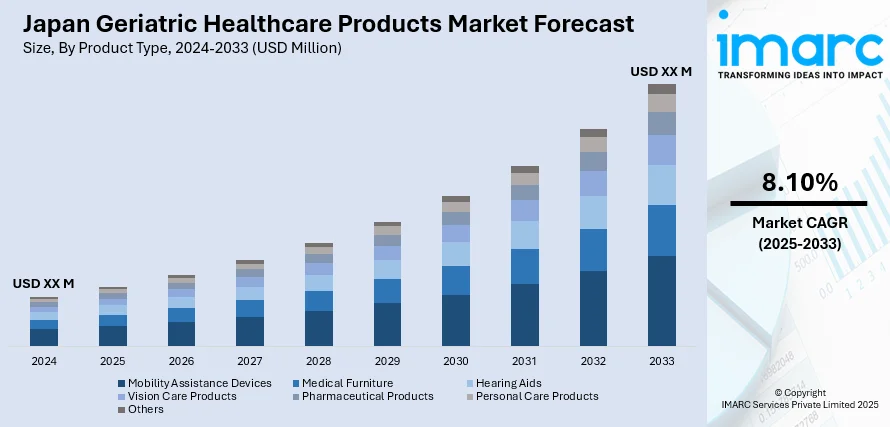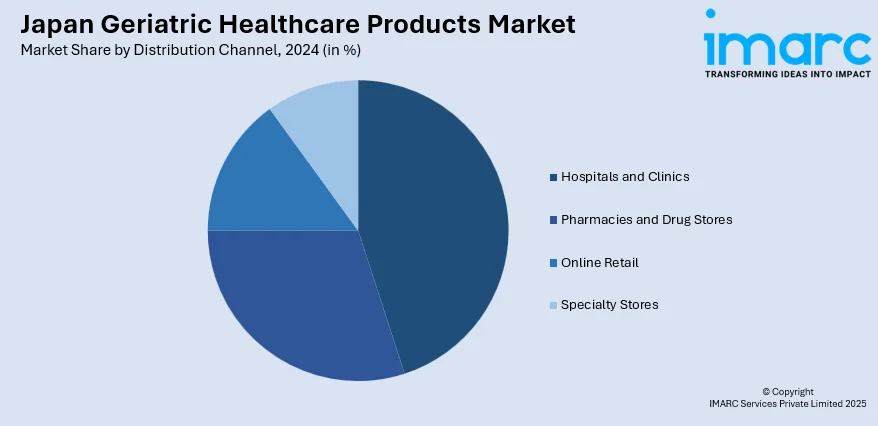
Japan Geriatric Healthcare Products Market Size, Share, Trends and Forecast by Product Type, Distribution Channel, End-User, and Region, 2025-2033
Japan Geriatric Healthcare Products Market Overview:
The Japan geriatric healthcare products market size is projected to exhibit a growth rate (CAGR) of 8.10% during 2025-2033. The market is fueled by the country's fast-growing elderly population and development of assistive devices to facilitate the daily lives of elderly. Technological innovations like, AI-enabled smart home systems and wearable health monitors, that improve the level of care and allow elderly people to remain independent are also driving the marrket. Government policies, such as the encouragement of home medical care and digital health technology, further increase the Japan geriatric healthcare products market share.
|
Report Attribute
|
Key Statistics
|
|---|---|
|
Base Year
|
2024
|
|
Forecast Years
|
2025-2033
|
|
Historical Years
|
2019-2024
|
| Market Growth Rate 2025-2033 | 8.10% |
Japan Geriatric Healthcare Products Market Trends:
AI and IoT Integration in Elderly Care Devices
Japan's geriatric healthcare products market is undergoing a revolutionary shift with the incorporation of Artificial Intelligence (AI) and the Internet of Things (IoT) in aged care devices. Industry reports indicate that over 10% of Japanese citizens are 80 years and above, and nearly 30% are above 65, which is a higher ratio than in any other country. Thus, such technologies enable real-time health monitoring, fall tracking, and tailored care plans, which enhance the independence and security of older adults. For instance, wearable sensors using AI can track one's vital signs and alert caregivers to potential medical conditions before they become life-threatening. Similarly, IoT-based home systems can offer an automated lighting and temperature control system, which is easy for the elderly to maintain a life of comfort. This innovation improves the lifestyle of the elderly as well as relieves caregivers and healthcare centers of their workload, thus emerging as a key trend fueling the Japan geriatric healthcare products market growth.

To get more information of this market, Request Sample
Home Healthcare Services and Products
With the aging population in Japan, there is a corresponding rise in the demand for home healthcare services and products meant specifically for elder care. This is driven by the preferences such as aging in place and maintaining pride for the elderly. Medical equipment that can be used at home is increasingly popular; the most common types are mobility devices, blood pressure monitors, and glucose monitors. Telemedicine consultations and home nursing services additionally make it possible for the elderly to obtain care easily from their very own homes. Such a transition is also aided by government initiatives in Japan to support home care, which intend to improve the healthcare experience of seniors and to alleviate hospital congestion.
Development of Assistive Devices for Daily Living
Greater concern for the development of assistive devices is now being geared toward facilitating the daily lives of elderly persons. There are a variety of aids ranging from those that facilitate mobility, such as wheelchairs and walkers, to those that assist with dressing or eating and using the toilet. Enhancements in these areas tend to give priority to safety, comfort, and usability. For example, mobility aids are increasingly being designed to reduce the effort exerted by their users and are being crafted with strong attention to ergonomic principles. Furthermore, advancements in materials and ergonomic design have led to products being less conspicuous and more aesthetic, thus generating greater acceptance among seniors.
Japan Geriatric Healthcare Products Market Segmentation:
IMARC Group provides an analysis of the key trends in each segment of the market, along with forecasts at the country and regional levels for 2025-2033. Our report has categorized the market based on product type, distribution channel and end-user.
Product Type Insights:
- Mobility Assistance Devices
- Wheelchairs
- Walkers
- Canes
- Medical Furniture
- Hospital Beds
- Lift Chairs
- Hearing Aids
- Vision Care Products
- Reading Glasses
- Contact Lenses
- Pharmaceutical Products
- Chronic Disease Medications
- Supplements
- Personal Care Products
- Adult Diapers
- Skincare
- Others
The report has provided a detailed breakup and analysis of the market based on the product type. This includes mobility assistance devices (wheelchairs, walkers, and canes), medical furniture (hospital beds and lift chairs), hearing aids, vision care products (reading glasses and contact lenses), pharmaceutical products (chronic disease medications and supplements), personal care products (adult diapers and skincare), and others.
Distribution Channel Insights:

- Hospitals and Clinics
- Pharmacies and Drug Stores
- Online Retail
- Specialty Stores
A detailed breakup and analysis of the market based on the distribution channel has also been provided in the report. This includes hospitals and clinics, pharmacies and drug stores, online retail, and specialty stores.
End-User Insights:
- Home Healthcare
- Assisted Living Facilities
- Nursing Homes
- Hospitals
A detailed breakup and analysis of the market based on the end-user has also been provided in the report. This includes home healthcare, assisted living facilities, nursing homes, and hospitals.
Regional Insights:
- Kanto Region
- Kansai/Kinki Region
- Central /Chubu Region
- Kyushu-Okinawa Region
- Tohoku Region
- Chugoku Region
- Hokkaido Region
- Shikoku Region
The report has also provided a comprehensive analysis of all the major regional markets, which include Kanto Region, Kansai/Kinki Region, Central /Chubu Region, Kyushu-Okinawa Region, Tohoku Region, Chugoku Region, Hokkaido Region, and Shikoku Region.
Competitive Landscape:
The market research report has also provided a comprehensive analysis of the competitive landscape. Competitive analysis such as market structure, key player positioning, top winning strategies, competitive dashboard, and company evaluation quadrant has been covered in the report. Also, detailed profiles of all major companies have been provided.
Japan Geriatric Healthcare Products Market News:
- In October 2024, the Japan Smart Healthy Aging QuickFire Challenge 2024 was introduced by Johnson & Johnson. Promising science or technologies that aim to potentially increase healthy life expectancy—to help people live longer, happier lives—were invited to be submitted by innovators based in Japan and those from around the world working on Japan-focused innovations. The innovator or innovators with the best ideas may be awarded grant money from a USD 200,000 pool, one year of virtual access to the Johnson & Johnson Innovation Asia Pacific ecosystem, and guidance from Johnson & Johnson experts.
Japan Geriatric Healthcare Products Market Report Coverage:
| Report Features | Details |
|---|---|
| Base Year of the Analysis | 2024 |
| Historical Period | 2019-2024 |
| Forecast Period | 2025-2033 |
| Units | Million USD |
| Scope of the Report |
Exploration of Historical Trends and Market Outlook, Industry Catalysts and Challenges, Segment-Wise Historical and Future Market Assessment:
|
| Product Types Covered |
|
| Distribution Channels Covered | Hospitals and Clinics, Pharmacies and Drug Stores, Online Retail, Specialty Stores |
| End-Users Covered | Home Healthcare, Assisted Living Facilities, Nursing Homes, Hospitals |
| Regions Covered | Kanto Region, Kansai/Kinki Region, Central /Chubu Region, Kyushu-Okinawa Region, Tohoku Region, Chugoku Region, Hokkaido Region, Shikoku Region |
| Customization Scope | 10% Free Customization |
| Post-Sale Analyst Support | 10-12 Weeks |
| Delivery Format | PDF and Excel through Email (We can also provide the editable version of the report in PPT/Word format on special request) |
Key Questions Answered in This Report:
- How has the Japan geriatric healthcare products market performed so far and how will it perform in the coming years?
- What is the breakup of the Japan geriatric healthcare products market on the basis of product type?
- What is the breakup of the Japan geriatric healthcare products market on the basis of distribution channel?
- What is the breakup of the Japan geriatric healthcare products market on the basis of end-user?
- What is the breakup of the Japan geriatric healthcare products market on the basis of region?
- What are the various stages in the value chain of the Japan geriatric healthcare products market?
- What are the key driving factors and challenges in the Japan geriatric healthcare products market?
- What is the structure of the Japan geriatric healthcare products market and who are the key players?
- What is the degree of competition in the Japan geriatric healthcare products market?
Key Benefits for Stakeholders:
- IMARC’s industry report offers a comprehensive quantitative analysis of various market segments, historical and current market trends, market forecasts, and dynamics of the Japan geriatric healthcare products market from 2019-2033.
- The research report provides the latest information on the market drivers, challenges, and opportunities in the Japan geriatric healthcare products market.
- Porter's five forces analysis assist stakeholders in assessing the impact of new entrants, competitive rivalry, supplier power, buyer power, and the threat of substitution. It helps stakeholders to analyze the level of competition within the Japan geriatric healthcare products industry and its attractiveness.
- Competitive landscape allows stakeholders to understand their competitive environment and provides an insight into the current positions of key players in the market.
Need more help?
- Speak to our experienced analysts for insights on the current market scenarios.
- Include additional segments and countries to customize the report as per your requirement.
- Gain an unparalleled competitive advantage in your domain by understanding how to utilize the report and positively impacting your operations and revenue.
- For further assistance, please connect with our analysts.
 Request Customization
Request Customization
 Speak to an Analyst
Speak to an Analyst
 Request Brochure
Request Brochure
 Inquire Before Buying
Inquire Before Buying




.webp)




.webp)












